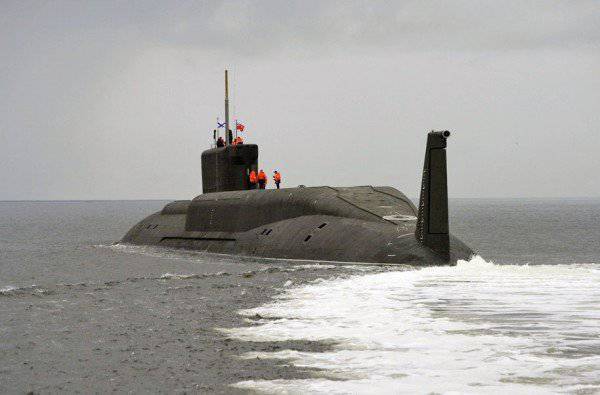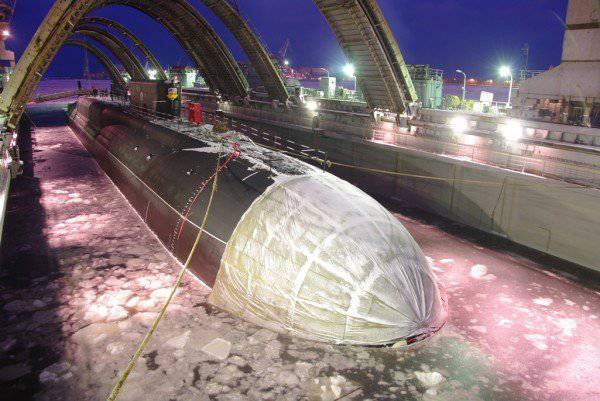Mace Dive
Initially, the tests were scheduled for the spring 2011 of the year, but for various reasons were postponed until this fall. During the tests, which, according to unconfirmed information, will last more than two months, in addition to assessing the ship’s propulsion, a salvo launch from the underwater position of the sea-based ballistic missile “Bulava-30” was carried out.
In total, the Yuri Dolgorukiy missile carrier has 16 rocket mines designed for launching missiles from an inclined position, which allows for launching missiles "on the move." According to RIA "News"," The launch and flight of the missiles proceeded normally, the missile warheads arrived at the Kura test site located in Kamchatka, at the scheduled time. As you know, this is the 17 th launch of the Р30 3М30 missiles Bulava-30, 9 of which were officially recognized as successful, the first tests began to be carried out back in 2004, but a great number of unsuccessful launches questioned the feasibility of further development of the Р30 3Х30. Failures were due to the violation of technology at numerous stages of the assembly of missiles, as well as the fact that poor-quality materials were used for the production of various component parts. Earlier previous launches of such missiles were made from the board of the Dmitry Donskoy nuclear submarine TK-208 (project 942U "Shark"), specially created as the carrier of the Bulava missiles.
According to sources in the Ministry of Defense of the Russian Federation, there are two more missile launches to be carried out, if they are successful, then it should be expected that the missile will finally be adopted by the Russian fleet. According to the schedule, the tests should end in December 2011 or at the very beginning of 2012.

The three-stage solid-propellant ballistic missile "Bulava-30" was designed at the Moscow Institute of Thermal Technology specifically for installation on strategic nuclear missile carriers. The chief designer of the rocket is Yuri Solomonov, he is also the developer of another ballistic missile, the Topol-M ICBM.
Compared to liquid fuel missiles, the Bulava is certainly inferior to them in terms of dynamic indicators, but solid-fuel missiles are more suitable for long-term storage, unlike liquid fuel missiles, which is an important factor when placing them on submarine rocket carriers. In the case of depressurization of rocket tanks with asymmetrical dimethylhydrazine used as fuel on liquid-fuel rockets, or tanks with an oxidizing agent (nitrogen tetraoxide), the consequences can be the saddest, the destruction of the K-219 nuclear submarine is a vivid example.
The construction of this type of sea-based missiles began in the 1998 year. The missile includes 6-10 units with nuclear warheads up to 150 kilotons each, equipped with an individual homing system. Each warhead can independently, depending on the designated target, change the trajectory of the flight. The maximum flight range is more than 8 000 km, the total launch weight of the 36,8 rocket tons, of which 18,6 tons falls on the first stage engine, the largest diameter of the 2 meter, the total length of all stages and the head part of the 12.1 meter.

To date, the Russian Navy has several ships capable of carrying the Bulava missile, the nuclear submarines Vladimir Monomakh, Dmitry Donskoy, Yuri Dolgoruky, Alexander Nevsky, but in the next five years , according to the adopted armament program, it is planned to adopt four more submarines of a similar type.
Nevertheless, it should be mentioned that, in general, the replacement of existing rockets with liquid fuel by the Bulava repeatedly, at least three times, reduces Russia's nuclear potential. The fact is that the total throw-in weight of submarine rocket carriers carrying on board the new Bulava-30 rocket, due to a significant reduction in payload, is two times less than in similar foreign projects. In addition, it should be said that the guidance of the domestic rocket and the drop weight are similar to the American rocket of this class Trident 2 (D5) UGM 133A (Trident), adopted by the US Army more than 20 years ago.
Today, according to some data, the US Navy has 16 carriers of this class of missiles. Our Russian latest “Bulava-30”, however, is inferior in some technical and combat parameters to similar Chinese developments and even the old American “Trident”, according to experts, the “Trident” has a higher potential for modernization than in “Bulava”, in which he is practically exhausted.
Information